
Sacred Texts Evil Index Previous Next
Buy this Book at Amazon.com


The Evil Eye, by Frederick Thomas Elworthy, [1895], at sacred-texts.com
ONE of the ways by which the influence included in the general term Evil Eye is communicated, is by touch. Mere bodily contact, as in the case of contagious diseases, has always been held to be of much importance as a means of conveying injury, and both by practice and precept has always been carefully guarded against. "Eat thou not the bread of him that hath an evil eye" (Prov. xxiii. 6) means, avoid his presence lest you come into contact with him; he may be blind, but his touch is malignant. Great as may be the power of mere personal presence, such as the rubbing shoulders with one possessed with the terrible faculty, the effect is tenfold greater when there is the actual and intentional touching by the baneful person. In the mesmeric performances with which we are all familiar, the influence of the operator is vastly increased when he makes passes with his hands, and still more so when he actually touches his patient. Then it is that he seems to convey to his subject the invisible influence of his own will, whether that will be in the direction of good or of evil. These evidences of the effect of personal contact, which our senses compel us to acknowledge, have been existent in all time,
and the consequence has been from the earliest days, that men have regarded with intense interest the instrument by which touch is commonly, and, when intentionally, always conveyed--the hand. Not only is it the bodily member which specially differentiates man from all lower animals, but it is that by which in every way he makes his power known and felt. True that man's relatives the Apes have four hands to our two, yet his are but prehensile instruments, incapable from the partial development of the thumb, apart from the brain-power of direction, of performing those thousands of intricate acts of construction, of musical touch, of significant gesture, which the human hand performs, and which mark it out as the faithful servant, as well as the natural symbol, of a higher power, that of a perfected intelligence.
If in past ages the hand has been looked upon as an instrument of evil when used by the malignant, much more has it been regarded as an instrument of good--the powerful protector against that special form of evil which was supposed to be flashed from one person to another, whether through the eye or the touch of malice.
It has ever been recognised that the differences of shape, texture, and general appearance of the hands of individuals are quite as great as in faces. Moreover, it has been noticed by long experience that certain kinds of hand are found to belong to the possessors of certain types of faces; and just as the life and character of the individual are to be seen in his face, so is his hand also the index of the mind. Further, it is found that just as the features of a person's face distinguish his individuality and
remain permanent, to be recognised by all who know him, so do the features--the shape, size, texture and markings on his hands--continue permanent, subject only to such changes as affect the features of his countenance. This fact is so well established by scientific research and record, that its results are being now applied to the identification of criminals, whose hands are carefully photographed or in other ways portrayed, as well as their faces. It is even proposed to apply the same method to the foot, which is also found to be different in every individual from that of every other. just as no two faces are alike, so are no two people's hands or feet.
The study of the hand as a quasi-science has of late become almost a mania, and the books on palmistry, or chiromancy, in all languages have become legion. Upon the hand, however, as an index of the life and character, we have no wish to enlarge, but refer the curious reader to such works as Shall I tell you your Fortune, my pretty Maid? by Mrs. John White, which the writer bought at a railway bookstall for sixpence, and which is marked "Twelfth Thousand"; to Chiromanzia, Fisiologia sulla Mano, Giulio Adrieu, Milano, 1884; Lira Una; or to the costly and elaborate compilations on the subject, which have appeared at recent dates. Indeed, so much has the fad of palmistry run riot, that one of the "up to date" enterprising soap-boilers has recently made use of it in a really clever puff upon a great hand, as an advertisement in some of the illustrated papers.
Our business, however, lies rather with the sister-science Chironomy than with this. The
latter is defined 377 as "the art or science of gesticulation, or of moving the hands according to rule in oratory, pantomime," etc. To this definition we venture to add, "the art of representing such gesticulation," etc., and this will be found later a needful qualification. As a science we are told 378 that chironomy is of great antiquity. "Numa Pompilius, the successor of Romulus, publicly made use of the art of chironomy, or of gesture with the hands, as a means of counting" (or reckoning, per conteggiare). "Not only Pliny the historian, but also Macrobius assures us, that Numa, in establishing a religion for the fierce Romans, caused a statue of Janus to be made with two heads, or with two faces, but with the fingers bent (piegate) in such a manner as to represent, according to Pliny, 379 the number 350, and according to Macrobius 380 the number 365."
In considering this evidence, we speak of making by the hand a certain gesture, a certain sign, which may convey (significasse) to all the Roman populace that which is meant by the words three hundred and fifty. Here then we have the conventional sign. If Numa had used a manual gesture, unknown to all, or if he had ordered the statue of Janus to be made with the fingers folded in a way which had not been in accordance with the previous habit or convention of the people, he would have been considered the most foolish of mankind. And therefore we are compelled to conclude the Romans to have then understood (intendessero) that part of chironomy as belonging to the gesture of counting. 381
The Abate says that the Romans obtained their gestures from the Greeks; that the Greek word
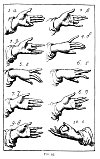
Click to enlarge
FIG. 93.
chironomia had been adopted (into Latin) to denote the art of gesture. He asserts that the invention of gestures for manual numeration was from the heroic
ages of Greece, and so of surprising antiquity; but he gives no hint as to the source whence the
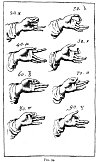
Click to enlarge
FIG. 94.
[paragraph continues] Greeks obtained it. He traces the use of this ancient method, and gives details of each position of the fingers of the left hand, so as to indicate any
number up to go (Figs. 93, 94). For instance he says:--
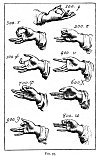
Click to enlarge
FIG. 95.
To indicate (pronunziare) the number 1, you have to bend the little finger (of the left hand) closely upon the palm of the hand. For 2, the ring finger is to be bent in the same manner. For 3, you do the same with the. middle finger. For 4, you raise
the little finger alone above the others. For 5, you raise the ring finger. For 6, you raise the middle and bend down the ring finger upon the palm. For 7, you raise the other fingers, and bend only the little finger so that the nail rests upon its own root, not on the palm. For 8, you are to make the same gesture with that called the medical finger, the next to the little finger. For 9, you do the like with the middle finger. For 10, place the nail of the index finger on the middle joint of the thumb. For 20, place the thumb between the middle and index fingers. For 30, unite gently the nail of the index finger and the thumb. For 40, place the index alongside the thumb. For 50, bend the index towards the palm like g, or Greek Γ. For 60, make the same bend with the thumb and at the same time press the bent thumb with the index surrounding it. For 70, bend the index as for 50, and fill the space with the thumb so that the thumb nail may be beyond the joint of the index. For 80, do the same with the index as for 70; then place the thumb in such a way that the thumb-nail may touch the joint of the index. For 90, make the nail of the index touch the root of the thumb.
No signs for the hundreds are made by the left hand. "One sees an exemplification of this, when Juvenal, alluding to Nestor, said that he counted the years with his right hand." 382
To denote hundreds, make the same gestures with the right hand as have been described for denoting the tens with the left. Hence to indicate 100, make with the right hand the same sign as is made with the left for 10 (Fig. 95).
Consequently you denote 200 with the right hand in the same manner as 20 with the left; and so on with the other hundreds.
Thousands are denoted by the right hand with the same gestures as by the left for the prime numbers 1 to 10. Hence 1000 is made with the right hand in the same way as 1 by the left, and so on.
Our author describes the way to denote tens up to hundreds of thousands, but enough has been extracted for our purpose, and to complete the explanation we here reproduce the plates (Figs. 93, 94, 95) with which he illustrates his subject, and which make it quite clear, so far as we have dealt with it. 383
The second part of the treatise deals with the gestures used by ancient actors and pantomimists; but inasmuch as he gives no pictorial illustrations, we despair of interpreting with sufficient plainness to be of interest to the reader.
The ancients having contrived so complete a system of manual numeration, it needs little imagination to understand how the hand, the emblem and instrument of power, naturally became in itself one of the earliest of protective amulets, probably coeval with the phallic emblems, at which we have but hinted in a previous chapter.
The earliest examples we have of the hand as an amulet against fascination--and we must take it almost as an axiom that all amulets had originally that object--are found, as we should expect them to be, singly or used separately; not combined with another object. The very rude representations of the hand shown in Figs. 96-101, from sketches by the writer,
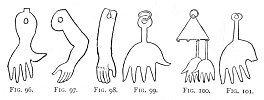
Click to enlarge
FIG. 96.-101.
are from early Etruscan tombs; all these are to be seen, with many more, in the Museums of the
[paragraph continues] Collegio Romano, of Cortona, of Bologna, and probably elsewhere. They are described as belonging "to the first age of iron," a period of extreme antiquity. The eyelets for suspension show that these objects were intended to be worn. They are mere pieces of bronze plate cut into the shapes, and about the sizes here drawn-perhaps a little larger. It is not easy to measure an article in a glass case. Fig. 100 has two hands remaining out of four which originally hung upon the same triangle. Whether or not the triangle represented anything more than a convenient shape for the suspender we cannot now decide--probably it did; but the fact of finding four hands combined shows that already in those days, 500 to 1000 B. C., there was a tendency to pile up amulets by way of adding to their power.
Among all these very early hand amulets, in only
 Click to enlarge FIG. 102 |
In the Ashmolean Museum are many examples of the open hand, in blue pottery, showing piercings or handle attachments for suspension as amulets. 384
[paragraph continues] Several of these latter are Phœnician and may therefore be the same as Etruscan.
Besides the small ones intended to be worn on the person, representations of the open hand are very widely scattered, and in such a manner portrayed both in sculpture and painting that we cannot but accept them as examples of that kind of amulet which was fixed in a conspicuous place for public protection, such as the grillo of Pisistratus, the horns on houses, and the gurgoyles on our churches.
Perhaps the most striking example of the use of the hand as a symbol of power as well as of protection, is to be seen sculptured on the tombs, excavated by that monotheistic Pharaoh, Khuenaten ("the beloved of the Sun's disc"), at Tel-el-Amarna. There he and his court are adoring the sun, whose rays are stretching out towards them; but in every case, and there are several such scenes in the tombs, each ray terminates in an open hand. The accompanying illustration (Fig. 103) is from Wilkinson, vol. iii. p. 52, the only drawing available, but it is unsatisfactory, and the writer regrets he made no sketch on the spot. 385 The date of these tombs is given as 1500 B.C., 386 and as their history is well known, this is probably one of the most exact in Egyptian chronology. The use of the hand as a sign of the divine presence and power is thus fixed at least as early as the sojourn of Israel in Egypt, and some time before the birth of Moses; it has continued to be so used throughout the ages down to the present day-alike by pagans, Mahomedans, and Christians.
Next probably in antiquity come the Etruscan
and Greek hands, made evidently for use as household amulets. Of these, two are to be seen in the Ashmolean. They are of bronze: one about six inches
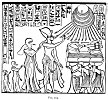
Click to enlarge
FIG. 103.
high, and fixed upright upon a flat plinth; another of the same kind, but larger, is late Greek, found at Taranto, in the temple of Dionysos. These are both exactly like Fig. 104, which has lost its stand, though retaining the pin by which it was fixed; the Oxford ones are both right hands. In the Naples Museum two are alike, Nos. 5507, 550S, a right hand
and a left, probably of much later date than the Etruscan, though of the same type of open hand without special gesture. The writer
 Click to enlarge FIG. 104. From Naples |
Fig. 105 is an Etruscan statuette from the Collegio Romano at Rome.
 Click to enlarge FIG. 105 |
unknown age, as well as modern Indian ones, 388 show that the pose and gesture of the hands are full of
 Click to enlarge FIG. 106 |
Belonging to later times, over the great gate of the Alhambra (Fig. 106) called "La Torre de Justicia," where the King or his Kaid dispensed judgment in Oriental fashion, 390 is a large upright hand on the keystone of the outer Moorish arch, in defiance of the strict objection of the Moslem to images. It is sculptured in low relief, the palm outwards, with the fingers and thumb in natural position. On this hand Ford 391 remarks that some consider it
an emblem of hospitality and generosity, the redeeming qualities of the Oriental. Others think it a type of the five principal
commandments of the creed of Islam: "To keep the fast of Ramadan, pilgrimage to Mecca, almsgiving, ablution, and war against the infidel." Others refer to the Hebrew jadh, the hand of God, the Oriental symbol of power and providence. But the true meaning of it is a talisman over the portal against the much-dreaded "Evil Eye," at which Orientals have always and do still tremble. The Morisco women wore small hands of gold and silver round their necks, like the Neapolitans, and a substitute for the classical phallic symbol of defiance. In the Sala de los Embajadores is an inscription to the same purport: "The best praise be given to God! I will remove all the effects of an evil eye upon our master Yusuf," etc.
Fully agreeing with Ford as to its real meaning, it may be noted as a coincidence that the act of taking a judicial oath is performed by Jews and other Orientals by holding up the right hand as thus depicted, also that a hand in this position upon the shield is the modern heraldic sign of baronetcy. 392
In the mosaics at Ravenna, seven centuries older than the Alhambra (Fig. 107), our Lord and two angels are all in the act of holding up the right hand in the attitude of benediction. One has the hand open and extended, another angel in the same group, not here shown, has the hand in the like position; at the same time more angels have the hand conspicuously making the other gesture here drawn, which we shall explain later.
In the Church of San Apollinare in Classe at Ravenna the saint is in the main tribune standing beneath a great cross, with the Apostles on either
side of him, represented by twelve sheep. He himself has both hands held up open, with palms outward, evidently in the act of benediction. Above the cross is an open hand coming out of a cloud,
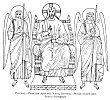
Click to enlarge
FIG. 107.--From San Apollinare Nuova, Ravenna. Mosaic of sixth cent. From a Photograph.
while on either side is a figure kneeling apparently on a cloud, but each of these latter is plainly making a conspicuous gesture with the hand--one with palm open and exposed, the other showing only the thumb and two first fingers. Above the arch of the tribune is a large medallion showing our Lord in the act of blessing the holy chalice; this He
holds in His left hand, while the right is raised, showing only the two first fingers and the thumb. On either side of the medallion are the typical symbol-figures representing the four Evangelists, each of whom seems to be presenting a book to the central figure.
St. Mark, the companion figure to St. Luke (Fig. 114), is shown with his right hand raised high, palm open and thumb extended. It is not of course suggested here that all these persons are making gestures against the evil eye, but they are singular pieces of evidence as to the importance of the hand itself, and of the position in which it is held both in acts of devotion and of benediction. 393
Considering the open hand as a distinctly used amulet of both ancient and modern times, we would call attention to its frequency at Tunis, where it may be seen displayed in a variety of ways over doors, or drawn upon walls in connection with the remarkable works of pictorial art by which the Haji announces his right to wear the green turban. These paintings upon the walls of the houses of returned pilgrims, although meant to portray animals and trees, are of such an exceedingly crude and rough sort that they can hardly be held to transgress the law that no Moslem shall make any object in the likeness of anything in heaven above or the earth beneath. In Tunis also may be seen many shallow drums, mere hoops of about two inches broad, having parchment
stretched on both sides, just as if an ordinary tambourine had two diaphragms instead of one. Each of these drums has a hand upon it like Fig. 104 upon one side, and on the other a double triangle.
 Click to enlarge FIG. 108. |
On inquiry about the meaning of these things, they say the hand is that of the Prophet. Seeing, however, that these drums are all ornamented round the rings with cowrie shells, fixed as they always are with the opening in the shells outwards, one could but form a further opinion: cowries have always been distinct amulets against the evil eye, 393a and it is but reasonable to assign the same purpose to the entire decorations. Tunisian Moslems are like other people, and pile up their defences by a combination frequently alluded to. The open hand is a very common amulet upon Neapolitan cab-horses (Fig. 83); indeed it may be accepted as a well-understood and completely-recognised protective amulet among all nations, whether represented by painting, by sculpture, or by gesture. We give two more convincing examples from far-distant quarters. On one of the great marble columns in the church-mosque of St. Sophia at Constantinople is a very remarkable
freak of nature. There is a white mark in the dark purple marble exactly like a spread-out hand; in fact it is so good a representation that one naturally fancies at first that it is artificial; but on close inspection it is found to be the natural marking of the marble. It is about the size of the human hand, and is really a conspicuous object when the visitor is conducted to the front of it, as he is sure to be, by the guides. The hand is near the Mihrab on the south side, about seven feet from the floor, and is held in the very highest reverence by the people as the hand of the Prophet. It is believed to protect all who go to pray near it from the evil eye. If this fine column had, as some declare, a previous existence in an ancient temple, who shall say to how many generations of men this strange piece of nature's art may have been an object of veneration? 394
In Fig. 77, from far-off North America upon the Mandan chief's robe, is the representation of the hand in the same position, placed there intentionally to ward off the evil eye of his enemy and to protect the wearer. How instinctively we throw up our open hand with palm outwards as a gesture prompted by surprise at any strange appearance, or to ward off any threat not amounting to actual violence! It is also thus used involuntarily to stop the undesired approach of any person or thing. In modern Neapolitan gesture-language "the raising of the hands naturally with the palms opposed to the object" signifies a negative to a question or
demand. It also signifies surprise, as with ourselves, and disapproval; 395 but to add effect to the gesture when vehemence is intended, in addition to the expression on his face, the actor violently spreads out his fingers, "le dita saranno violentemente
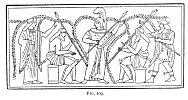
Click to enlarge
FIG. 109.
allargate l'uno dall' altro," precisely as drawn upon the robe of Mah-to-wo-pa (p. 200).
Judging, however, from Canon Jorio's description of his plates, in four of which (Nos. 5, 6, 17, 18) the attitude is shown, with descriptions in the text, it would seem to be more like our own, an involuntary act of astonishment than of well-understood and significant gesture. 396 As a sacerdotal act it is of course recognised everywhere, though he does not
allude to it in that aspect, nor does be indeed to any priestly action.
Precisely the attitude we are describing is to be
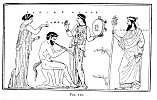
Click to enlarge
FIG. 110.
seen in a very characteristic painting by Perugino on the soffit of one of the famous stanze in the Vatican,
that of the "Incendio di Borgo." In it our Lord is represented as ascending into heaven, but both hands are raised with open palms as though to wave off St. John and the other saints pressing around. In the four compartments of this vaulted ceiling our Lord holds one or both hands in special attitudes: in three making the sign with two fingers and thumb, the priestly benediction, and the fourth as above described, with both hands open wide, with palms outwards.
Among the Romans the hand was a specially favourite ornament, and was constantly placed upon household articles. In the Naples Museum are seen, from Pompeii and elsewhere, handles of stoves, braziers, and of many other utensils, flattened out into broad open hands where riveted to the body of the article. Door-knockers from Pompeii, of a pattern still commonly seen in Italy, have a hand grasping a ball, with the hinge at the wrist. We cannot look upon these hands as simply decorative, but suggest that they were used intentionally as well-known protective amulets, powerful indeed when simply open, but doubly so when bent into certain well-defined and recognised attitudes.
in the Ashmolean Museum among the Egyptian amulets is a clenched hand pierced for suspension; it is of rude modelling in blue porcelain, but it is evident from its general contour that it is meant for the same position as that shown in the Etruscan hand from Bologna (Fig. 102).
There is another of these in the Ashmolean which is also a small amulet to be worn, from Umrît, said to be Phœnician. The position of these hands is one which has evidently had a special meaning from very early times, and is still common everywhere, even here in England: in Italy it is so common that it has a technical name of its own, the mano fica. This has ever been a gesture of defiance and of insult among all nations. It denoted persumma ignominia to the Romans, 397 and among all the Latin races it was connected with the fig, 398 and so conveyed a hässlich idea. In French faire la figue, Italian far la fica, Spanish hacer el higo, all denote this particular gesture of the thumb between the first and second fingers. Our English idiom of "Don't care a fig," which expresses the contemptuous idea, and implies the gesture, has its counterpart in the German Fragen den Teufel. The gesture is everywhere perfectly well understood, though the Teuton does not connect it with the fruit. 399 In classic times the hand in this position was well known as manus obscæna. 400 Everybody is familiar
with this gesture, which, if it has somewhat changed its meaning, has in all these ages by no means lost its force. The two following quotations seem to give it a northern habitat, but here in Somerset it is too common even to be noted.
Dean Ramsay remembered how in Yorkshire he and his schoolfellows, from 1800 to 1810, "used to put our thumb between the first and second finger, pointing it downwards as the infallible protection against the evil influences of one particularly malevolent and powerful witch." 401
They placed in the hand of the Midsummer Witch a vessel of the same kind with a long, narrow neck.
"It is filled with water," continued Judith, "drawn by herself from the sea on this very evening. Now, child, double thumb and come along."
Everybody knows that to double your thumb in your right hand averts danger. 402
We have already fully described (p. 150) the amulet
 Click to enlarge FIG. 111 |
The most used amongst us is as an amulet against the evil eye; and the Neapolitans utter the expression, "Te faccio na fica," as if they would say to a friend "May the evil eye do you no harm!"
This meaning is identical with that of making horns in the amulet sense; in fact when making this gesture they often pronounce the same sentence as they use in making horns against fascination.
"Mal-uocchie non ce pozzano!" ([may] evil eyes not overwhelm you, literally, "throw down a well"). The only difference is that the mano in fica has a little more force than the horns in the idea of those who have faith in it.
Among Italians this gesture has the same meaning as among us and other people far and near--that of intense contempt or defiant insult. In this sense it is referred to by Dante, 404 and twice by Frezzi. 405 Trissino 406 also uses it, almost copying Dante.
Jorio describes this as a most insulting gesture, equivalent to our "A fig for you! Go to Bath!" except that the Neapolitan equivalent fuori grotta, as a low, "outside-the-barrier" sort of place, carries infinitely more scorn than "to Bath." 407
Another meaning of the sign, beyond the limits of our present purpose, is discussed under the heading: "Invito turpe."
In offering or presenting any object to another
person in order to avert any evil which may accompany it from the giver, when the article is of such a nature as to need support of the closed hand (pugno), it ought, in such case, to be held in the position of mano in fica. If the object be such, per esempio, as a plate held by thumb above and finger under, then the other fingers are to be placed a mano cornuta, of which we have now to speak.
This position of the hand is shown five times in Fig. 112 by the hand alone, also grasping a key and a flower, as amulets in silver and other materials; also on the Indian goddess (Fig. 115) grasping rings.
The Neapolitans have but one gesto to imitate horns, but so great and so many are the qualities and diversities of its signification, that these (latter) apply not only to this gesture, but also to natural horns, to their resemblances, and even to their simple name.
Thus Jorio 408 begins his dissertation of over thirty pages upon Corna, far le corna, and after referring to the multitude of writings on the subject, says he shall consider it under the following heads:--
1. What kind of horns do the Neapolitans use? 2. The ideas they associate with horns, of whatsoever kind they may be, including the gesture and the word horns. 3. Finally, if the ancients had in whole or in part the same ideas and the same customs, or at least the same gestures, as the moderns relating to the horn. The words horn or horns are used indifferently, and apply alike to the horn alone or to the two which adorn the heads of animali corniferi.
He says of natural horns, that those of bullocks, the most used, are to be seen in gardens, on the top of palings, on the houses even of the nobility; that in these latter, the horns of Sicilian oxen are most in request. Those of rams and goats, of which wine-sellers
and the lower classes make most use, are suspended in the inside of the houses, or at the door, and sometimes in the window. Less common are those of the stag, which may be seen dangling

Click to enlarge
FIG. 112.--From the Author's Collection.
at the doors of chemists' and grocers' shops, who, if they are able, obtain the horns of the elk, known as the Gran bestia. Of buffaloes' horns scarcely any are to be seen; when seen they are suspended in dark or ignoble places. These distinctions, not di rigore,
are often modified according to the ease with which any kind of horn can be procured.
Artificial horns are made chiefly for the convenience of carriage on the person. Hence they are fashioned in small sizes and with much elegance. The most frequent material is coral, but plenty are to be had in gold, silver, mother of pearl, amber, or lava. One of the vendors not long since exposed for sale some exceedingly minute mani cornute, in gold, silver, coral, etc., and the business done proved that the artist knew the wants of his countrymen.
Whether through lack of horns, real or artificial, or whether it be that among us (Neapolitans) the idea of the horn is so widespread and deeply rooted that few will be without one, the fact is, that they have at length got to consider as a real horn any object whatever that resembles it. The following objects are therefore most particularly used. The claw of crab or lobster, cocks' spurs, claws or teeth of animals, as those of tigers and wild boars, horseshoes, half-moons, etc.
The word horn. When the Neapolitan has need of a horn for any purpose, and has not either a real or artificial, nor anything resembling one, he makes use of the name, uttering the word horn or horns once or oftener according to the force he intends to give. 409
As a gesture. The index and little finger extended, the middle and ring finger clasped by the thumb, as shown in many illustrations.
The hand thus posed and raised vertically gives a very good imitation of the head of a horned animal, and therefore we give to this gesture the name of the horned hand (mano cornuta). just as this unique sign imitating horns has very many different meanings, so we attach to it all the diverse ideas which belong to the word horn.
As a potent gesture protecting against the evil eye, the mano cornuta is constant and persistent. A Neapolitan's right hand is almost constantly in that position, pointing downwards, just as the hand charms are made to hang downwards, and in this position they take the place of an amulet worn habitually against unknown and unsuspected attacks. Of all the ideas connected with the mano cornuta, that of fascination holds by very far the largest place.
When, however, it is desired to use the sign specially against a particular individual, the hand so posed is thrust out towards him, and if there is no fear of his person, towards his very eyes, from which so much is dreaded. That is, of course, if he be present, but if absent, the sign is made in the direction of his supposed whereabouts.
Jorio 410 tells a story of a sprightly Napoletana who was over-credulous of the effects of fascination.
Observing that another lady whom she believed to be a jettatrice was highly praising the beauty of her husband, and especially of his well-formed thighs and legs, she wished to have recourse to the horn. Not having at hand the grand preservative, nor being able to supply it (openly) by a gesture, and what is more, not believing the repetition by her lips of the word corno, corno, corno, to be sufficient, she pretended to have need of a handkerchief. She therefore put her hand into her husband's pocket, and there made the mano cornuta. Then, with the points of her index and little fingers well extended, began to stab the thigh bone of her husband with such force, as if she wanted to pierce through it (bucarlo): indeed, if she did not pierce it, it was only because she could not. Nor did she leave off her preventive operation until the believed jettatrice turned her talk in another direction. Neapolitan ladies wear little horned hands of various materials suspended at the end of a necklace, which is ordinarily hidden in the breast; but whenever a person appears who is suspected of being a jettatore, the hand quickly goes to the necklace, and the amulet is brought out, dangling in the direction considered necessary. As etiquette does not permit this to be
done openly in society, they pretend to be adjusting the kerchief, but the fact remains, that they seek to make sure of, and to touch if possible, the gran preservativo del fascino.
Over and above its use as a preventive gesture, the mano cornuta when raised vertically towards the person's own forehead denotes what some consider an ornament, the exalted horn; but on the other hand, when pointed towards the chin, it implies conjugal infidelity to the husband. This idea is not by any means confined to Italy. In Brand, under the heading "Cornutes," is a long chapter upon this subject, and we gather that at least in Brand's time the gesture made with the little and fore fingers had the same meaning here in England that it has still in Italy--where at the present day the gesture made, as last described, is looked upon as an unpardonable insult which blood alone can wipe out. Amongst ourselves the gesture seems to have quite died out and become forgotten, the result, we hope, of improved morals; but during the seventeenth century the perpetual allusion to cuckolds and horns is a distinct blot upon the literature of the period. Shakespeare has many allusions to the subject, though less in proportion than many of the coarser dramatists. 411
Addison complains 412 that "cuckledom is the basis of most of our modern plays," showing that it was still common talk. We know it was a frequent topic in the last century, yet now the words seem quite to have dropped out of literature. No quotation
of the word could be found for the New English Dictionary later than 1728 without going to Ford's Spain, where the word is referred back to the sixteenth century.
Both the gesture and its implication are still well known in all European countries. "Faire les cornes à quelqu'un!" "Porter les cornes"; "Far le corna a uno"; "Portar le corna"; "Llevar los cuérnos"; "Einem Hörner aufsetzen" ("to cuckold any one"); "Hörner tragen," are all identically the same in meaning.
How the notion first arose and where, are points of great difficulty. Brand discusses the question at great length, gives many recorded opinions, but leaves it unsolved. He places its origin according to the earliest data he produces at the time of the Crusades; but Jorio declares the ancient Greeks to have used the horns, and also the gesture, in the same signification as at present: further, he dwells on the extreme antiquity of the use of the fingers as representing them. He considers the cornucopia of Amalthea the she-goat, the symbol of abundance, to have been an amulet. 412a Also he places the Rhyton of Dionysus in the same category, as well as the musical horn; and he winds up by declaring that their signification "è particolarmente di amuleto contro del fascino." He describes the various amulet horns, their shapes, their being deprived of all ornament except at the point, their mode of attachment or suspension, their representation in (ancient) pictures and bronzes accompanied by the phallus, especially at Herculaneum, where they appear also upon the household utensils (arnese). He also refers
to the horns found among the fruits depicted on the walls of Pompeii, and says that "our Neapolitan fruiterers," who display their goods so openly outside their shops, "never fail to place among them a fine pair of horns, for the purpose of keeping off other folk's envy, evil eyes, fascination." 413
He refers to the only two isolated horns of metal discovered, one of bronze, the other of iron; both are solid, and so could never have been cups, and consequently they could have been of no use except for suspension. He also describes the heads of two oxen, from the mouths of which proceeds the phallus. The latter are referred to and depicted by Jahn, Taf. V. Another bronze from Herculaneum, no longer to be seen in the Royal Museum, is an ox's head, intended for suspension, on which are grouped three half-moons and three phalli.
Jorio describes at length, in much detail, a plaster (intonaco) from Herculaneum in which one of the male figures is making the mano cornuta with the left hand. He gives his full reasons why the figure is not intending insult, or for any of the other purposes (than the protective) to which the gesture is applied, and concludes the long discussion by declaring that "at such an action, one of our Neapolitans would not have hesitated a moment to exclaim: Benedica! mal-uocchie non ce pozanno!" He says the Museum has abundant examples of this gesture as an amulet contro al fascino, and concludes with: "In the vast field of amulets, every one was known to the ancients, and the moderns have not added thereto one single Corno." 414
Again, the sixth century mosaics 415 of Ravenna give us further illustrations. In Fig. 113 the remarkable hand appearing from the clouds, representing the Almighty, is very plainly in the position we have been considering, and looking at the scene in which

Click to enlarge
FIG. 113.--From San Vitale, Ravenna. Mosaic of the sixth century.
it occurs we cannot but regard it as a feature of great importance. In the same church and in others at Ravenna the hand is seen coming out of the clouds,
especially in the scenes of Abraham's sacrifice of Isaac (Fig. 116), and of Moses putting off his shoes before the burning bush (Fig. 117); but in no other
 Click to enlarge FIG. 114 |
A bull standing and fully represented, as the symbol of St. Luke (Fig. 114), is very rarely seen; the saint himself is shown very conspicuously making the well-known gesture as if to guard both himself and his bull from the assaults of evil eyes.
Fig. 115 is from a small brass statue of an Indian goddess, evidently of modern date, now in the County Museum at Taunton. The unmistakable position of both hands is a proof of the very widespread importance attached to the gesture of the mano cornuta, and is a convincing proof of what has been before remarked--that the gesture of the hands in ancient statues has a meaning, and is not, as in modern sculpture, dependent on the whim or taste of the artist. It is to be noted here also that this Indian statuette has one of the horned hands pointed down in true more Neopolitano.
When we see the same thing in the early Christian art of the sixth century at Ravenna, and in the present day pagan art of India, we are compelled to admit that symbolism is independent of religious faith, and that there is something in special positions of
the hands, which both pagan and Christian alike recognise.
The several gestures in the Ravenna mosaics are both interesting and remarkable;
 Click to enlarge FIG. 115. |
second, and fourth fingers extended, with the third or annularius closed upon the palm. The same position is depicted on the angel next but one on the right of our Lord enthroned, in the famous series at San Apollinare Nuova. 416 Again, in
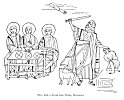
Click to enlarge
Fig. 116.--From San Vitale, Ravenna.
the scene of the three men entertained by Abraham (Fig. 116), supposed to represent the three Persons of the Holy Trinity, they are severally making all three of the gestures described. Two are raising the right hand in the act of blessing, of whom the central figure makes the orthodox Greek
sign, while the personage on his left makes the Western sign, and the third shows the open hand. The position of the thumb
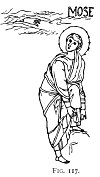 Click to enlarge FIG. 117. |
It is certain that these gestures are intentionally depicted, and also that they denote sacerdotal rank; for later, by many centuries, we find the same thing in the Giotto frescoes at Assisi. There Saint Francis is painted with his hands displayed so as to exhibit the stigmata, but, inasmuch as he was never a priest, his hands are simply crossed upon his breast; while a mitred bishop, in the next panel, has his right hand lifted in the benedictory gesture, which by that time had become the only one used in the Western Church. 417
Among the simple amulets there are two other positions of the hand, as shown in Fig. 112. The forefinger alone extended is referred to by Jorio very frequently as a gesture, but not described by him as one used against the evil eye, yet the writer
knows well that it is undoubtedly made and sold thus, as an amulet for that purpose. Those shown were purchased at a shop in the native quarter of Naples, and the writer believes he has seen the single forefinger, pointed up, fixed upon a horse's back, but could not find one in the shops which supply the saddlers. This gesture is, however, very clearly marked in Fig. 74, where the Indian goddess Indranee is shown as the celestial mother with her child. The hand having the points of thumb and forefinger touching, as shown in No. 3 on Fig. 118, though also extremely common, with a great variety of uses in the gesture language, is not, as a mere: gesture, an amulet according to Jorio. 418 Jorio quotes the Abate Requeno's system of numeration, and points out that the sign so made means thirty (Fig. 94), and that in number-lore thirty signifies le nozze (marriage), while sixty represents widowhood. We cannot follow these authors into all their ramifications, which are outside the evil eye, but the hand in this position is, we repeat, commonly made and sold as an amulet against it, although the gesture itself is not one. I t will be noted from Fig. 118, No. 3, and Fig. 119, No. 5, that it is made with both right and left hands, whereas the left only signifies thirty, while the right in this position denotes three hundred. As a horse amulet this position of the hand is rather a favourite; and we may consider it to be adopted by those cabmen who, desire the custom of ladies-it being well understood by all what the gesture indicates (le nozze). As a gesture, however, it may be one of the most insulting,
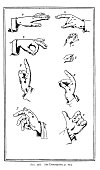
Click to enlarge
FIG. 118.
See Description, p. 274.
though its chief significance, according to Jorio, 419 is inimicizia (enmity); but by slightly altering the shape so as to form a circle it has a totally different signification, disprezzo (contempt). In both these meanings there is a distinct flavour of defiance, and perhaps on that account it may have been adopted as an amulet in the concrete form. 420
Examination of any varied collection of charms will show that the hand is a common amulet in itself, also that it is used in combination with other objects: sometimes merely grasping them, and sometimes, while grasping the actual charm, making at the same time the important protective gesture. 421
The silver hand grasping the dart is a prominent one on Fig. 112, and is one of the commonest to be seen. Another in coral holding a short sword appears on the same plate just above the serpents. In the Woburn Marble (Fig. 24) the gladiator is grasping a short sword; and again in the Cimaruta (Chap. X.) one of the branches ends in a hand grasping a sword. Moreover this arm grasping a dart, spear, or sword in various positions is one of the commonest of heraldic crests of the present day. One of the charms (on Fig. 112) is a key, and another the lotus; both are in mano cornuta. Two others are the mano in fica, one combined with a shell and the other with a flower-bud of some sort. The important one, however, is that at the end of the spada or sword. This is a hand grasping the lotus, and is no doubt considered a very potent charm.
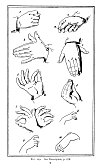
Click to enlarge
FIG. 119.
See Description, p. 276.
[paragraph continues] The spada is of silver, about six inches long, and is worn in the back hair by any girls rich enough to procure one. The specimen here shown has been much worn, and is a decidedly bright and effective ornament. Another coral arm is grasping a fish; a hand grasping a fish, perhaps a dolphin, is also to be seen on the Cimaruta. The fish is an undoubted amulet, as may be seen on the gems, Figs. 16, 18.
None of these things are alluded to by Jorio, and we may accept it therefore as an axiom that the only two gestures, apart from the concrete, which of themselves constitute protective amulets, are the mano cornuta and the mano in fica.
We have reproduced here, as not out of place, the three pages of illustrations given by Jorio of the principal gestures in common use among Neapolitans of to-day. Concerning these, he has given full explanations and descriptions in the text. They are not, of course, strictly connected with our subject, yet so much has been said respecting manual gesture, and so many amulets exist in which the position of the hand is an important factor, that we cannot think these numbered attitudes, with a translation of their corresponding interpretations, will prove uninteresting.
FIG. 118.
|
1. Adagio. Minaccia. Mediocramente. |
1. Gently, soberly. Threat, menace. Indifferently, middling, so so. |
|
2. Mano cornuta. pei suoi diversi significati. |
2. Mano cornuta in its various significations. |
|
3. Giustizia. Perfetto. Minaccia. |
3. Justice. Perfection, all right. Threat. |
|
4. Poco. |
4. Little (in quantity). |
|
5. Additare (v. l'Indice III). Indice solo disteso. |
5. To point with the forefinger. (He gives no less than twenty different meanings for this gesture.) |
|
6. Schioppetto pei diversi suoi significati. |
6. A gun, a musket, in its various significations. |
|
7. Ladro. |
7. Thief. |
|
8. Bere. Additare. |
8. Drink. To point. |
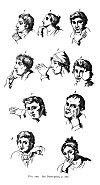
Click to enlarge
FIG. 120.
See Description, p. 276.
Of course, where two or more significations may be given by the same position of the hand, the meaning is supplemented by facial and other expression. Jorio gives 32 pages to the explanation of No. 2, Fig. 118.
FIG. 119.
|
1. Mano in fica. |
1. (Sufficiently explained.) |
|
2. Danaro. |
2. Money, coin. |
|
3 and 4. Stupido. |
3 and 4. Stupid, blockhead. |
|
5. Amore. |
5. Love, liking, attachment. |
|
6. Chiedere. |
6. To ask, to beg, to request. |
|
7. Condotta versipelle. |
7. Cunning, malicious conduct or behaviour. |
|
8. Schioppetto. |
8. Gun, musket. |
|
9 and 10. Disprezzo. |
9 and 10. Contempt, disdain. |
FIG. 120.
|
1. Silenzio. |
1. Silence, hold your tongue. |
|
2. Negativa. |
2. Denial, no. |
|
3. Bellezza. |
3. Beauty. |
|
4. Fame. |
4. Hunger, I want food. |
|
5. Besseggiare. |
5. To make a long nose, to mock, etc. |
|
6. Fatica. |
6. Labour, fatigue. |
|
7. Stupido. |
7. Stupid, blockhead, donkey, asses' ears. See p. 416. |
|
8. Guercio. |
8. Squint-eyed. |
|
9. Ingannare. |
9. To cheat, to deceive. |
|
10. Astuto. |
10. Crafty, cunning. |
Only a study of the curious book itself can afford full information upon all these gestures.
236:377 New English Dictionary, s.v. "Chironomy."
236:378 Scoperta della Chironomia ossia dell' arte di gestire con le mani, Dell' Abate Vincenzo Requeno, Parma, 1797, p. 13.
236:379 "Janus geminus a Numa rege dicatus, qui pacis, bellique argumento colitur, digitis ita figuratis, ut trecentorum quinquaginta dierum nota per significationem anni, temporis, et ævi se Deum indicaret."--Pliny, xxxiv. 7.
236:380 "Simulacrum ejus plerumque fingitur manu dextera 300 et sinistra sexaginta quinque numerum tenens, ad demonstrandam anni dimensionem."--Macrobius, Saturn. i.
236:381 Abate Requeno, op. cit. p. 14.
240:382 Abate Requeno, op. cit. p. 40.
240:383 Before venturing; to reproduce this interesting system for which the Abate claims such antiquity, great pains were taken to ascertain if it is known and practised in our English systems of teaching the deaf and dumb. The p. 241 constant reply of experts, as to whether this or any similar system of manual numeration was taught, has been: "I know of no ancient system"! Only by a negative process has it been found that this system is not used by modern teachers. It is therefore here recorded as bearing much on what has to be said upon gestures of the hand, so intimately connected with the belief in the evil eye.
242:384 Jahn, Aberglauben, etc., frequently uses this argument as a proof that the objects he is speaking of were used as amulets, e.g. p. 47, of a female figure with the hand on the mouth he says: "Die sich zum Theil durch den Henkel als Amulete ausweisen."
243:385 Another plate, with the sun's rays terminating in a hand, is in Wilkinson, i. 40.
243:386 E. Wallis Budge, The Nile, p. 13.
245:387 In the Ashmolean Museum are three small Egyptian amulets evidently for suspension. They are open hands of the usual blue pottery, but small, and almost identical in type with many a coral hand to be seen to-day in the Naples shops. No doubt the open hand has been worn as a protection throughout the thirty centuries since these little charms were made.
246:388 See Fig. 115, p. 267, which, though modern, probably represents by Oriental unchangeableness equal antiquity.
246:389 This is fully supported by the account given by the Abate Requeno of the statue set up by Numa Pompilius, in which the pose of the hands was specially ordered.
246:390 Deut. xvi. 18; Dan. ii. 49; i Kings vii. 7.
246:391 Murray's Handbook for Spain, 1855, vol. i. p. 301.
247:392 The arms of Ulster are simply a large hand in this position, filling up the entire "field." Perhaps the most apt and the best-known illustration of the holding up of the hand as a powerful gesture is the account in Exodus xvii. 11: "And it came to pass, when Moses held up his hand, that Israel prevailed; and when he let down his hand, Amalek prevailed." Then because he could not hold it up continually it was held up by Aaron and Hur. The Scriptures are full of examples showing the great importance of manual gestures.
249:393 The frequent reference in Scripture to the lifting up of the hands fully confirms the importance of this attitude of prayer: "Lift up your hands in the sanctuary" (Psalm cxxxiv. 2). The lifting up of my hands as the evening sacrifice" (Psalm cxli. 2). "I stretch forth my hands unto thee" (Psalm cxliii. 6). "He lifted up his hands, and blessed them" (St. Luke xxiv, 50). See also Psalm xxviii. 2, lxiii. 4, cxix. 48, and many other passages.
250:393a See Fig. 13. Jahn also explains what these shells typify. Phallic students will readily understand them.
251:394 This hand shows precisely the same gesture as those over the arch at the Alhambra, and upon the drums of Tunis. "The open hand was represented on the coins of some of our Saxon kings in the tenth century; on one it is accompanied by Alpha and Omega" (Twining, Symbols and Emblems of Early Christian Art, p. 6).
252:395 Mimica degli Antichi, Andrea de Jorio, Napoli, 1832, p. 227.
252:396 Fig. 109, No. 17 of Jorio, is from a Greek vase published by Millin--vas. ec. V. I tav. 66, by Inchirami, Galleria Omerica, ec. tav. 76. He says that of this picture Minerva is the protagonista, the central object towards whom the eyes of all the other figures are directed. The scene appears to represent a council of armed heroes, amongst whom Minerva brandishes her lance. A careful study of the gestures leads to the conclusion that there is a difference of opinion between those on her right and those on her left, for reasons which he points out.
Minerva turns her face to the right, while she raises her left arm with the hand open; she seems to be in the act of stepping forward to the left, and is pointing her left hand while brandishing her lance in the same direction. The old man sitting on her right is holding his right hand spread out and reversed, as if to signify "Go gently," or "Don't excite yourself." The woman standing raises her left hand with palm extended as if saying to the goddess, "Listen! Keep quiet!" These two figures then being in tranquil attitudes seem to say, "Wait; go carefully; the business is doubtful." The sitting warrior has his left band open, palm upward, a little raised--a position when the hand is flat denoting a question asked, while the raising it upward denotes much disapproval of the words of his opponents. The standing figure behind him has his right hand raised so as to show vivacity in his whole body, and indicates his entire and active disapproval of the counsel of the others. The whole picture represents Minerva proposing some great operation, which those on her right discountenance, and advise prudent waiting, while those on the left support and urge it with heat and animosity.
The whole picture is one of manual gesture telling a plain story.
Fig. 110, No. 18 of Jorio, is from a vase in the collection of Sir John Coghill, and is fully described by Millingen. Jorio says the principal figure p. 254 is Bacchus, closely watching the conversation of the other persons, who are at the same time making gestures as ancient as they are modern, relating to a special quarrel between the two women. The one on the left, fixing her eyes on her companion, and thrusting out her right forefinger to accentuate her look, says with emphasis, 'Thou!' That this 'thou' is intended as a reproach may be argued from her look; but more certainly from the attitudes of herself as well as of her companion. Indeed she also stares back at her, lifts up both her arms in angry surprise and denial at the same time. Further, with the like significance, she throws back the upper part of her body, so as to enable her to steady herself on her feet. The other person, perceiving the anger of her opponent, raises her left hand and with thumb and forefinger makes the sign of love or friendship (see 5, Fig. 119). Jorio points out how cleverly the artist has told the story, and how plain all these things are to a Neapolitan: how that jealousy is shown in the left-hand woman, while the satyr goes on playing his pipes in apparent unconcern, while Bacchus also is taking the liveliest interest, etc.
255:397 John Prætorius, De Pollice, Lipsiæ, 1677, p. 42. He refers to the Italian phrase "far le fiche."
255:398 "The fig and the phallus were carried in processions in honour of Bacchus. Hence in Italy arose the term far la fica."--Payne Knight, Symb. Lang. p. 30.
255:399 "To fig" (a person) is, "Einen durch Trotz oder Verachtung andeutende Verwegungen mit den Fingern beleidigen" (Hilpert).
255:400 This is described by Ovid (Fast, v. 433): "Signaque dat digitis medio cum pollice junctis."
"Favebant ii, qui manum in obscænum modum formabant."--De Pollice, 43.
256:401 Atkinson, Forty Years in a Moorland Parish, quoted in Athenæum, May 23, 1891, p. 662.
256:402 Walter Besant, Dorothy Forster, 1885, p. 7. Scene laid in Northumberland.
256:403 Mimica degli Antichi, p. 155.
"Al fine delle sue parole il ladro
Le mani alzò con ambeduo le fiche,
Gridando: Togli, Dio, chè a te le squadro."
Inferno, Canto xxv. 1-4.
"E fe le fiche a Dio 'l superbo vermo."
Il Quadrir, ii. 19.
"E fe le fiche a Dio il mostro rio,
Stringendo i denti ed alzando le braccia."
Ib. iii. 10.
"Poi facea con le man le fiche al cielo
Dicendo: Togli, Iddio; che puoi più farmi?
L'Italia Liberata, Canto xii.
The latter authors are quoted by Cary.
"Se poi viene un susurrone
E lodando vi scompone,
Presto il pollice volgete
Sotto l'indice, 'l tenete
A lui ritto ritto in faccia
Sin che parti, ovver si taccia."
Marugi, Capricci sulla Jettatura, p. 134.
The author says in a note: "This is the most efficacious of all the expedients up to this time practised. Make trial of it, and you will be grateful to me."
258:408 Mimica degli Antichi, Napoli, 1837, p. 89.
260:409 Mimica degli Antichi, Napoli, 1837, p. 92.
261:410 Mimica, p. 100.
262:411 "It shall hang like a meteor o'er the cuckold's horns" (Merry Wives of Windsor, Act ii. Sc. 2). "An old cuckold with horns on his head" (Much Ado about Nothing, Act ii. Sc. 1). Marston in his Malcontent, Act iv. Scene 5, calls Agamemnon, Prince Arthur, and Hercules, cornutes. So also Ben Jonson in Every Man in his Humour, Act iii. Scenes 3 and 6, also in Act v. Scene 5, alludes to both horns and cuckolds.
262:412 Spectator, No. 446.
263:412a See Mano Pantea, post, p. 318.
264:413 Mimica degli Antichi, p. 109.
264:414 Mimica, p. 120. It has already been remarked that every species of p. 265 charm of whatever kind soever against the evil eye is called in the vernacular un corno; hence the above. Later on we shall see that he is mistaken, or at least some have been invented since his day.
265:415 The illustrations from the Ravenna mosaics are all from photographs in the writer's possession, obtained on the spot.
268:416 This angel is not shown in Fig. 107, but in the great mosaic it appears next the angel with the open hand.
269:417 The importance attached to manual gesture in the rites of the Roman Church is proved by the minute directions as to the position in which the celebrant is ordered to make the sign of the cross at Mass. He is to turn the little finger of the right hand towards the object which he is to bless, keeping the right hand straight with the fingers extended and joined together with the thumb (from Pontificale Romanum, Venetiis, 1836).
270:418 The hand in this position is, however, made and sold as an amulet. One of these is on Fig. 83 as a horse amulet, and a small one in coral is on Fig. 112, among the charms for personal wear.
272:419 Mimica, pp. 46, 126.
272:420 This gesture is called the Phallic hand (Forlong, Rivers of Life, p. 461).
272:421 This is seen again in the Indian goddess, Fig. 115, who is grasping two large rings while making the mano cornuta with both hands.